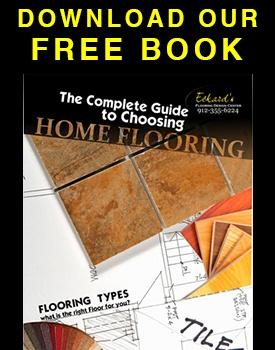The kitchen is, in most homes, one of the busiest areas of the house. This is where a lot of work gets done with liquids, chopped food, high temperatures, cutting, and more. In many cases, this is also where the family eats, so there’s a greater risk of dropped food and spilled liquids on the floor. This is one of the reasons why—while you can do it—most floor experts would advise against putting in carpet. With all the things that can potentially go wrong in a kitchen, having a fabric surface that will absorb liquids is not a good idea.
Then there’s vinyl, which has often been touted as a very practical—but not especially aesthetic—alternative. But is that still true in the 21st century? Absolutely not, and here’s why.
Sheet Vinyl
This is the vinyl that many current homeowners may remember from their childhood, or even have in their own home if they bought an older residence that hasn’t been remodeled in some time. In terms of value, there are three things you want to look at in flooring; quality, cost and style. Traditional sheet vinyl brings the most value for quality and cost, at the expense of style.
This is, as the name implies, a sheet of solid vinyl that is laid over a foundation of cushioning.
The vinyl material is incredibly durable, and flexible. This means that it won’t chip the way stone or tile might when heavy objects are dropped on it. It also means that it’s highly resistant to moisture, so humidity does not warp or otherwise degrade the quality of the floor. It’s also incredibly easy to clean, with a quick mop or wipe of a cleaning cloth to handle any spill or mess, with no absorption into the floor.
Luxury Vinyl Tile
If traditional sheet vinyl gives you performance and good pricing at the cost of good looks, luxury vinyl tile gives you great performance and fantastic looks at the price of a lower cost. This is a more expensive option compared to sheet vinyl, but you get what you pay for.
What “LVT” brings to the kitchen is the same durability and quality, but now, you can bring in more looks and even textures to the floor, to make it look and feel like another material. If you want a kitchen floor that stands up to abuse but looks like a hardwood floor, LVT can do that. If you want something that looks—and feels—like a stone tile floor with bumps and other surface features for more traction, LVT can imitate this look as well.
Advances in technology have made it possible for LVT to imitate the look and texture of many other materials while sacrificing none of the durability, performance, and reliability of sheet vinyl. It’s a very intelligent compromise for people that want a floor with the aesthetic appeal of other materials, but none of the structural weaknesses.
For people that know they are going to put their kitchen through a lot of work, vinyl has always been a “go to” material for reliability. However, now, thanks to the debut of LVT, that reputation for quality at the cost of style is no longer true. You can get a floor that looks like whatever material you imagine but gives you the full protection of vinyl, all at a cost that meets your budget.



